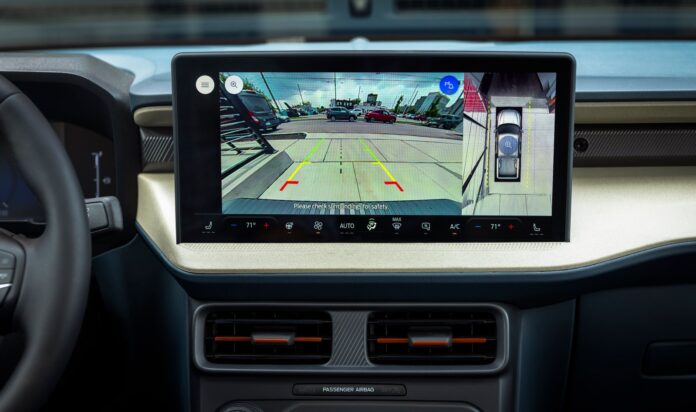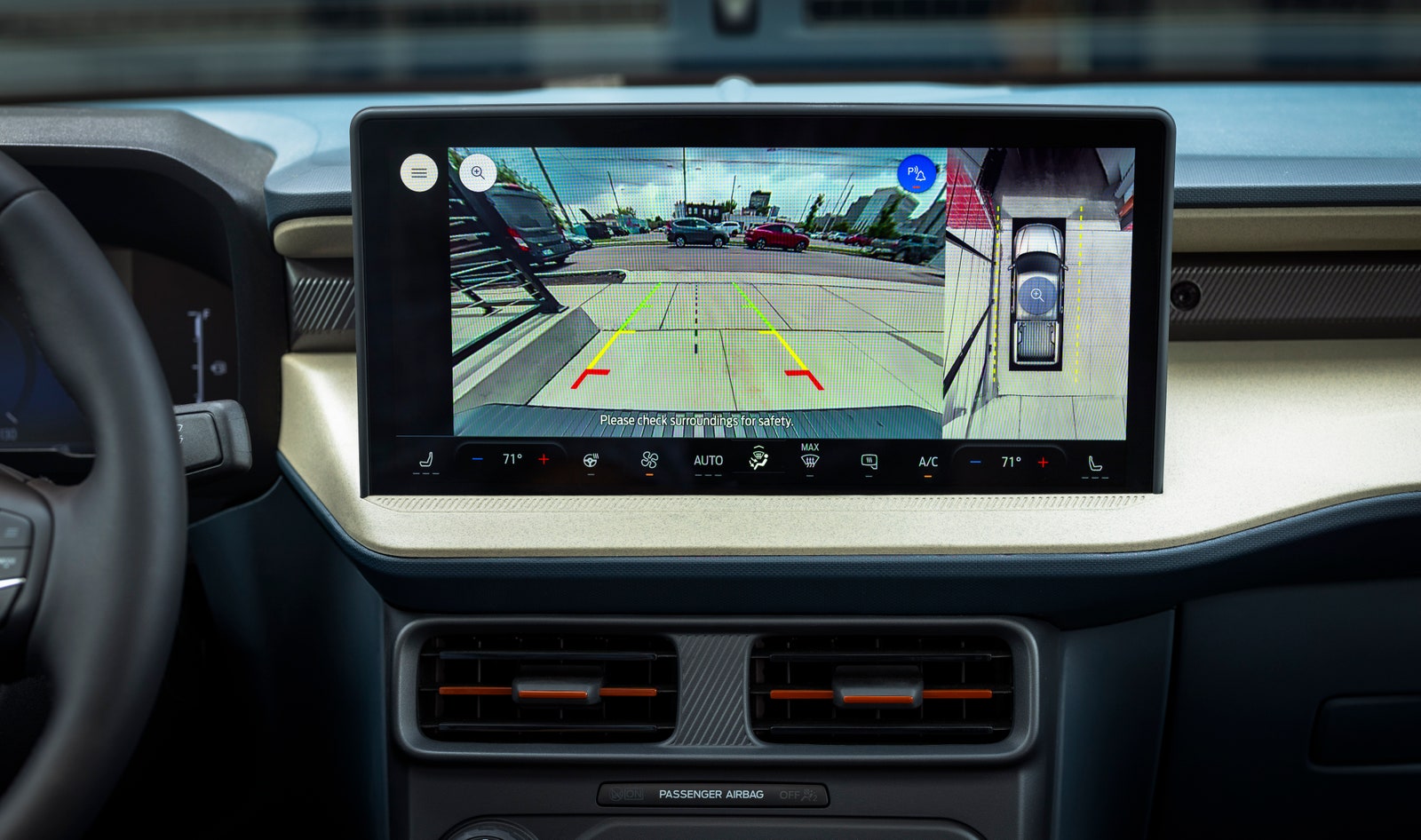Ford created a surprise smash hit when it introduced the Maverick in 2021. This compact pickup, built on architecture shared with the Escape and Bronco Sport crossover SUVs, offered truck capability in a fuel-efficient, sensibly sized package. Now, Ford has introduced updates for the 2025 model year that make the Maverick even more appealing.
First and foremost: Customers will finally be able to order the Maverick with the thrifty hybrid engine and all-wheel drive. Previously, Ford limited the hybrid powertrain to front-wheel-drive models. This maximized fuel efficiency, earning stellar EPA estimates of 42 city miles per gallon, 33 highway, and 37 combined. But this decision limited the model’s appeal: Buyers who wanted all-weather capability or needed to tow more than the hybrid’s 1,500-pound maximum had to upgrade to the 2.0-liter EcoBoost four-cylinder engine, rated at 22 city mpg, 29 highway, and 25 combined when paired with all-wheel drive.
“Hybrid all-wheel drive was by far the top request from customers,” Dawn McKenzie, Ford Truck communications manager, told WIRED via email. McKenzie explained that in the initial rollout, the hybrid model was limited to front-wheel drive to maximize affordability—indeed, Ford promised a base price of $19,995 when the Maverick was introduced for the 2022 model year, though for 2024 the cheapest Maverick starts at $23,920, with the hybrid engine currently a $1,500 option. Ford sold more than 94,000 Mavericks in 2023, over half of which were hybrids.
For 2025, the Ford Maverick comes in a kaleidoscope of flavors. The base model Maverick is a front-wheel-drive hybrid, rated at up to 42 mpg. Adding optional all-wheel drive is expected to drop the fuel economy slightly, to a still-respectable 40 city mpg. (Official EPA ratings have not yet been released.) An optional towing package, now available on hybrid Mavericks, allows trailers up to 4,000 pounds. If the hybrid’s 191 horsepower and 155 foot-pounds of torque aren’t enough, the 238-hp, 275-foot-pound EcoBoost non-hybrid turbo four-cylinder is still available on all models.
Hybrid Pickups Pick Up
Hybrid pickup trucks are kind of having a moment. Ford introduced the hybrid F-150 PowerBoost in the 2021 model year. Toyota introduced an optional hybrid drivetrain to the full-size Tundra pickup truck for 2022, and later this year Ram will add a plug-in-hybrid to its light-duty truck. (General Motors does not currently offer a hybrid version of the Chevy Silverado or GMC Sierra, though rumors indicate the automaker is scrambling to add a plug-in variant.)
By hybridizing their pickup trucks, automakers seem to be spreading their bets. Overall, electric vehicle sales are still climbing in the US, but once-skyrocketing year-over-year increases are starting to level out. In the pickup truck world, EVs are still a tiny niche. Ford is thrilled to point out that the all-electric F-150 Lightning is the best-selling full-size electric pickup truck in the United States, with 2023 sales up 55 percent compared to 2022. But the Lightning is vastly overshadowed by its own internal combustion siblings: Ford sold more than 750,000 F-series pickup trucks in 2023, but only slightly more than 3 percent of them were all-electric.
A few factors are at play. All-electric, full-size trucks are drastically more expensive than their internal combustion counterparts. The 2024 F-150 Lightning starts at nearly $63,000, compared to $37,000 for a gasoline-burning model; the base-model Chevy Silverado EV starts at roughly $75,000. The Rivian R1T starts at $70,000, and Tesla’s promised $60,000 Cybertruck has just been canceled, meaning you now can’t buy one for much less than $100,000.
Electric trucks also face an uphill battle with buyers. Internal combustion pickups are heavily marketed on how much they can tow and haul. In 2022, Car and Driver gathered three electric pickup trucks, hitched up a 6,100-pound camper trailer to each, and made it only 140 miles on a fully-charged battery in the best-performing truck.
In ideal conditions, charging up a nearly-dead EV will take around 40 minutes at a public fast-charger, assuming you can find one. For truck owners who tow, this could turn the ride to the boat launch or campsite into an all-day slog. With the US’s charging infrastructure currently struggling, an electric pickup is likely to be a nonstarter for anyone who tows with their truck.
What Took Them So Long?
Hybrid technology has been present in the US market for more than 20 years. It’s almost a wonder that we’re just now seeing it in pickup trucks. Electric motors are most powerful at low speeds, meaning a hybrid truck can benefit the most from its battery when it’s working the hardest: Accelerating from a dead stop when loaded down with heavy cargo or a big trailer.
Hybrids also use much smaller batteries than full EVs, making them far less expensive to build and buy—and for customers used to filling up at a gas station, they don’t require any change in driving habits.
Ford CEO Jim Farley seems to be bullish on hybrids. “We should stop talking about it as a transitional technology,” the executive said at an event in May. His view runs counter to his Detroit colleague Mary Barra, CEO of General Motors, who appeared at the same industry event. Regarding hybrids, Barra said, “it’s not the end game because it’s not zero emission,” emphasizing that full electrification is still GM’s long-term strategy.
Right now, most major automakers are prioritizing hybrids, in part due to uncertainty over future regulations that could impact battery production and internal combustion sales alike.
Farley brought up another reason why he’s excited about hybrids, one that helps explain the changes to the 2025 Maverick. “Many of our hybrids in the US are now more profitable than their non-hybrid equivalent,” Farley said at that event in May. Indeed, the 2025 Ford Maverick now starts at $26,295 for a base-model truck, with the previously optional hybrid drivetrain now standard.
Source : Wired

















